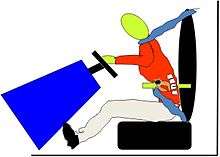Seat belt syndrome

Seat belt syndrome is a collective term that includes all injury profiles associated with the use of seat belts. It is defined classically as a seat belt sign (seat belt marks on the body) plus an intra-abdominal organ injury (e.g. bowel perforations) and/or thoraco-lumbar vertebral fractures.[1] The seat-belt sign was originally described by Garrett and Braunstein in 1962 as linear ecchymosis of the abdominal wall following a motor vehicle accident.[2] It is indicative of an internal injury in as many as 30% of cases seen in the emergency department. [3][4] Disruption of the abdominal wall musculature can also occur but is relatively uncommon.[5]
Pathogenesis
Seat belt syndrome is caused by hyperflexion of the spine around the lap strap in sudden deceleration leading to crushing of intra-abdominal contents between the spine and the seatbelt. Fixed portions of the bowel such as proximal jejunum and distal ileum are more susceptible to injury than mobile portions since mobile segments can escape the high pressure and resultant damage.[6]
Symptoms
The symptoms associated with this syndrome depend on the injured organ. In the case of hollow organs injuries, peritoneal signs may appear. While in the case of parenchymal or vascular injuries, hypovolemic signs dominate the clinical picture.[1]
References
- 1 2 TORBA, M.; HIJAZI, S.; GJATA, A.; BUCI, S.; MADANI, R.; SUBASHI, K. (1 September 2014). "Seat belt syndrome, a new pattern of injury in developing countries. Case report and review of literature". G Chir. 35 (7-8): 177–180. PMC 4321524
 . PMID 25174292 – via PubMed Central.
. PMID 25174292 – via PubMed Central. - ↑ Wotherspoon, Sonya; Chu, Kevin; Brown, Anthony FT (1 March 2001). "Abdominal injury and the seat‐belt sign". 13 (1): 61–65. doi:10.1046/j.1442-2026.2001.00180.x – via onlinelibrary.wiley.com.
- ↑ Masudi, Tahir; McMahon, Helen Capitelli; Scott, Jennifer L.; Lockey, Andrew S. (1 January 2017). "Seat belt-related injuries: A surgical perspective". J Emerg Trauma Shock. 10 (2): 70–73. PMC 5357874
 . PMID 28367011. doi:10.4103/0974-2700.201590 – via PubMed Central.
. PMID 28367011. doi:10.4103/0974-2700.201590 – via PubMed Central. - ↑ Girelli, G.; Di Natale, R.; Manocchi, M. C.; Lutman, M. (1 October 1993). "[Seat belt syndrome]". Radiol Med. 86 (4): 444–452. PMID 8248580 – via PubMed.
- ↑ Wagner, AC. "Disruption of abdominal wall musculature: unusual feature of seat belt syndrome". 133 (4): 753–754. doi:10.2214/ajr.133.4.753.
- ↑ Abbas, Alaa K.; Hefny, Ashraf F.; Abu-Zidan, Fikri M. (1 January 2011). "Seatbelts and road traffic collision injuries". World Journal of Emergency Surgery. 6: 18. PMC 3121590
 . PMID 21619677. doi:10.1186/1749-7922-6-18 – via BioMed Central.
. PMID 21619677. doi:10.1186/1749-7922-6-18 – via BioMed Central.